Why the explosive debate over asylum seekers could define the next federal election
With political barbs flying and hate-filled incidents on the rise, a dramatic new poll suggests most Canadians think securing the border is more important than helping migrants—and that the country can’t take any more refugees
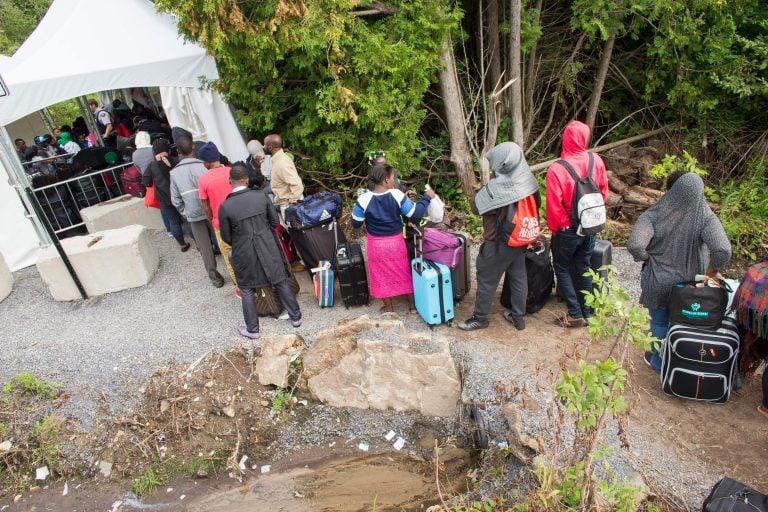
A long line of asylum seekers wait to cross the Canada/US border near Champlain, New York, on August 6, 2017. (Geoff Robins/AFP/Getty Images)
Share
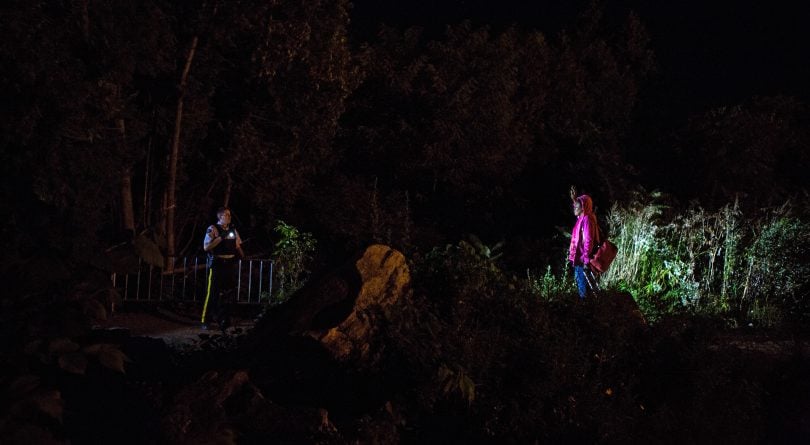
As concern spreads about a lack of shelter space in Toronto for a recent influx of refugee claimants, Orangeville Mayor Jeremy Williams was expressing nervousness an hour’s drive northwest of the quandary. His town, with around 30,000 people and a cherished heritage main street, doesn’t have space for the hundreds of border crossers who had arrived in Quebec via a quirk of Canada-U.S. border law, he says, just in case government officials wanted to ask him. And besides, wasn’t this the federal government’s problem to figure out, especially after Prime Minister Justin Trudeau’s #welcometoCanada tweet 18 months ago as the influx of border crossers was beginning? “I have to stand up for our citizens and say, ‘Hey, we’re a kind people, we’re welcoming, but if you’re going to have a wide-open policy, don’t make it so that we have to scramble to pick up the pieces,’ ” Williams tells Maclean’s. While immigrants make up nearly half of Toronto’s population, they only account for 12 per cent of Orangeville’s—not that the mayor says he or his town have issues with refugees or newcomers. Williams notes his mom immigrated to Canada. “She followed the rules, like a good member of Canadian society.”
Closer to Toronto, Markham’s Mayor Frank Scarpitti discussed with several counterparts the challenge of housing the asylum seekers. He was greeted with a weekend protest and some harshly worded signs: “Not in my backyard” and “Illegal free rider not invited.” (Most protesters were Chinese-Canadian, as are some civic election candidates; Chinese nationals have long made up one of the largest cohorts of Canadian asylum seekers, though they tend to claim by other means than walking across the U.S.-Canada border.)
READ MORE: The new underground railroad to Canada
Another stubborn—and more consequential—protest has emerged in downtown Toronto, in Queen’s Park. Newly minted Premier Doug Ford and his majority government have cut off co-operation with the Trudeau government on border crossers and demanded $200 million in repayment for lodging and assisting them, calling the “illegal border crossers” a “mess” completely of Trudeau’s creation. This aligns well with federal Conservatives’ steady attack drum in recent months. To the Trudeau government’s great consternation, the opposition dubs it a “crisis.”
The Liberals would much rather term it a “challenge” they can manage. Along with refugee advocates, they argue that calling the migrants “illegal” is unfair and misleading, as Canadian and international refugee law withholds punishment for refugee claimants for finding whatever way they can into a country where they seek protection. The government speaks of its international legal obligations and contingency planning for further cross-border surges, and reminds the country that there’s no choice but to give claimants a fair refugee hearing. But the public seems to have little regard for rhetorical or legal nuances.
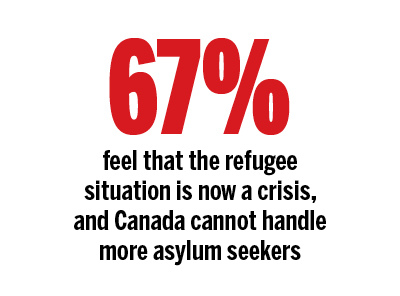
Two-thirds of Canadians believe it is indeed a crisis, and 65 per cent feel the 30,000 refugee claimants arriving from the U.S. since January 2017 are too many people for Canada to handle, according to a new Angus Reid Institute survey provided to Maclean’s. More concerned about border safety than assisting migrants, Canadians feel, by a wide margin, that Conservative Leader Andrew Scheer would handle this file better than Trudeau.
Ottawa has won support for welcoming more than 50,000 Syrian refugees through government and private sponsorship programs. But asylum seekers who come to Canada in hope of being granted protection rather than first securing it overseas tend to get a rougher reception, especially when their arrival is as visible as that of the migrants who tote luggage across the boundary ditch at Saint-Bernard-de-Lacolle, Que. Conservative politicians often warn that public support of the country’s whole immigration system rests on the continued belief that the system is controlled and well-managed. They’re doing what they can to bolster views that with the border crossers, it’s not—and Canadians seem to agree.
One year before the next federal election, it’s clear the asylum situation has emerged as a problem—or crisis, or challenge, call it what you will—for the ruling Liberals. For Canadians, it’s a kind of real-time values test.
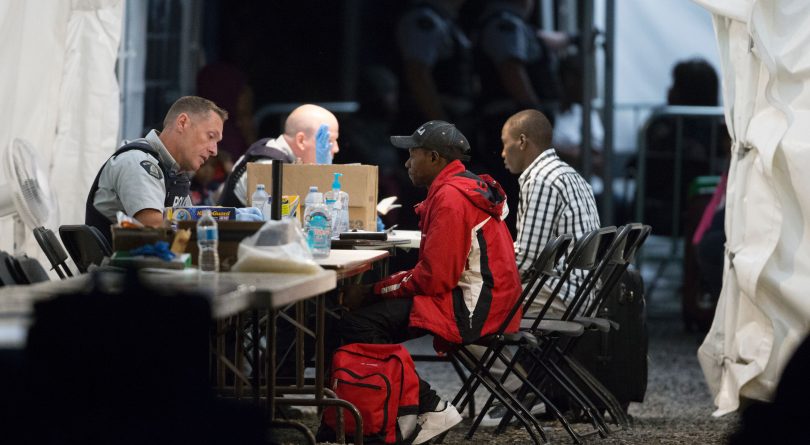
Opposition MPs attempted to keep border crossers a hot summer issue by summoning MPs back to Ottawa in July for an emergency session of the Commons immigration committee. Behind a veneer of fact-finding was each side’s talking-point jousts with little listening and even less understanding.
Michelle Rempel, the immigration critic, asked if the Liberals had explored unilaterally scrapping what she calls a “loophole” in the country’s Safe Third Country Agreement that allows Canada to turn back asylum seekers who come over from the United States, but only if they show up at recognized border crossings. Bill Blair, the newly minted minister of border security, began to answer about the logistical problems of turning the whole border into a port of entry: “It’s an issue, quite frankly, that I’ve had an opportunity to very briefly discuss with officials, and they explained the impact of that, which would be very problematic in many ways…” Rempel interjected: “Just in the interest of time, I’ll take that as a no.”

The Liberals were happy to return the favour. At the committee, Liberal MP Peter Fragiskatos questioned Ontario Social Services Minister Lisa MacLeod about whether she was familiar with the legal implications of a past court ruling on asylum claims—MacLeod began talking about the province’s spending on immigrants and social assistance, and Fragiskatos jumped in: “I don’t mean to interrupt you, but there is limited time. I guess the answer to that question is no.” On it went. The Conservatives’ bid to paint the government as feckless and naive, the Liberals’ to paint the opposition as uncaring and xenophobic. Even though Blair’s new cabinet title suggests border security is a priority on this file, in a six-hour debate, nobody once questioned whether the migrants pose a security risk. Conservative criticism focused on costs and management, while the committee’s lone New Democrat criticized Liberals for not cancelling the Safe Third Country pact with America.
Conservatives may not have had to push the security angle, which Canadians seem to already have front of mind. In the Angus Reid survey conducted in late July, 71 per cent of respondents said Ottawa should mostly or exclusively devote resources to policing the border, while 29 per cent prefer to focus on assisting arrivals. With border attention already a concern, the opposition appears bent on conveying the assistance spending as a fiasco.
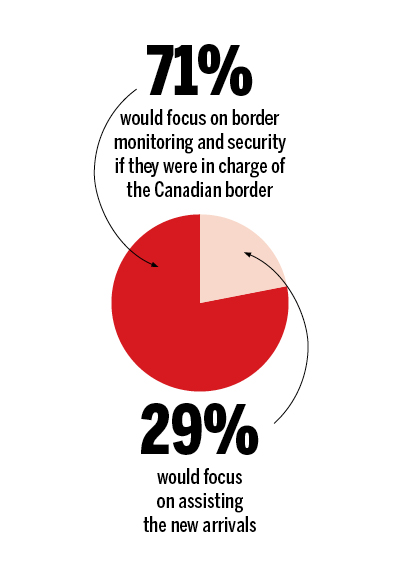
The core DNA of conservatism is appreciation for the rule of law, observes Chad Rogers, a long-time conservative strategist. Crossing where there’s no border guard is a basic affront, as was a Trudeau tweet that seemed like an invitation to would-be migrants, he says. “These issues are cornerstone and obvious: there’s a process and you wait your turn, even if you’re in need. There’s nothing that motivates conservatives more than the butting-in-line stuff.”
The oft-discussed Trudeau tweet came in January 2017, the day U.S. President Donald Trump signed a refugee and travel ban aimed at Muslim-majority countries: “To those fleeing persecution, terror & war, Canadians will welcome you, regardless of your faith. Diversity is our strength #WelcomeToCanada.” Border crossings by asylum seekers had begun to sharply rise before this point, and the biggest rush of refugee claimants wouldn’t happen until that summer, including thousands of Haitians worried about the Trump administration’s deportation moves. But the National Post’s reporting confirmed the tweet directly triggered refugee inquiries internationally, and some Haitian immigration promoters used Trudeau’s tweet in their own messages. Trudeau’s tweet appears to have been but one factor in the increase of asylum traffic, along with Trump’s words and deeds and the political pressures pushing refugee movements to new levels throughout the globe.
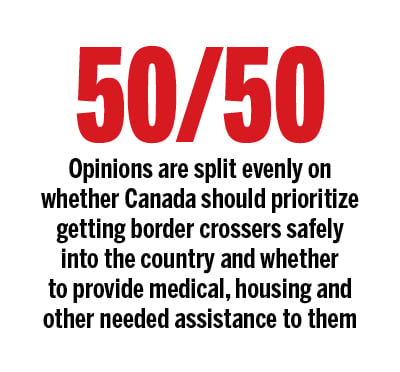
One unseemly attack on Trudeau’s tweet backfired on Conservative operatives. In an ad on the Conservative party’s Twitter account, Trudeau’s tweet was artistically represented as a bridge across a moat, with a black man wheeling a suitcase across it toward an opening in a chain-link fence and Canada’s woods over yonder.
A newspaper column’s headline accompanies the ad: “Trudeau’s holier-than-thou tweet causes migrant crisis—now he needs to fix what he started.” The Conservatives quickly deleted the depiction of a black man breaking into Canada; a party spokesman said the border situation isn’t about any one group of people. A stupid and sloppy mistake, says Rogers—“and why it was so extremely stupid was it validates the suspicion people have of conservatives that they’re all secretly white racists.”
The following day, as the Prime Minister appointed Blair in a cabinet shuffle, he stressed it as a response to his rivals’ divisive ways. “When conservatives across the country are playing the fear card, we need strong, reassuring voices to counter that,” Trudeau said.
RELATED: How Canada’s border towns are dealing with a steady stream of refugees
The Conservatives’ deleted tweet still may have found an audience—some Conservative supporters hear dog whistles when they aren’t necessarily intended, Rogers says. “The Conservatives sadly inherit part of the populist yahoo vote that is a little less educated, less sophisticated and less tolerant of people who are different,” the strategist says. Some Canadians’ overt nativism and racism show up in a disturbingly recurrent series of viral videos posted to social media: “Go back to your f–king country!” shouts a woman at a Denny’s in Lethbridge, Alta., in May. “It’s my f–king province!” a white man said to a Muslim man in a heated confrontation at a Toronto ferry terminal. Hard-right social media tried to link the Danforth shooting to ISIS; in the attack’s aftermath, the National Council of Canadian Muslims reported a spike in hate-related incidents, according to the National Post.
Unlike much of what pollutes the immigration and refugee debates in the U.S. and Europe, Canada’s politicians generally steer well clear of blunt go-home-we-don’t-want-’em rhetoric. But at the emergency committee about border crossers, Jean-Nicolas Beuze of the United Nations refugee agency lobbed a warning at MPs: “We hope that the populist rhetoric which seeks to gain short-term voting support will not bias the discourse and discussions that we have on those people.”
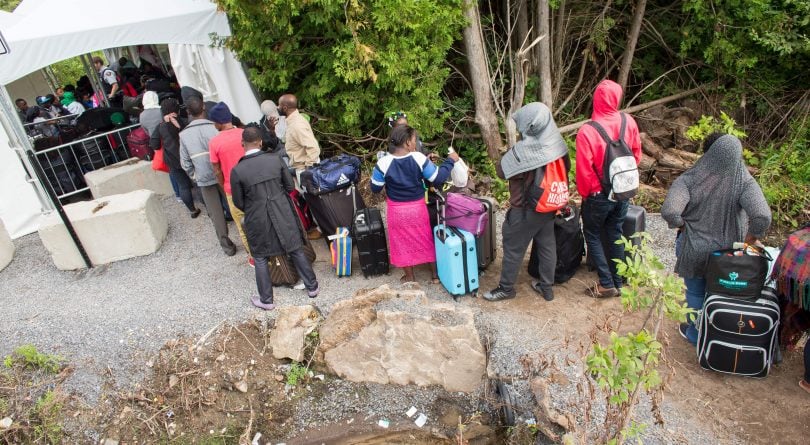
By midsummer, the border-crossing saga was heading in two directions at once. On one hand, the number of crossers declined to 1,263 in June, the quietest month in a year—thanks largely, the Liberals said, to their diplomatic pushback on Nigerians getting U.S. visas and heading straight to the New York-Quebec line. On the other hand, Nigerians and other newcomers who did cross the border were increasingly heading from Lacolle to Toronto instead of Montreal, further burdening a shelter system already stressed by an affordable-housing crunch. Hundreds of migrants are staying on college campuses and will have to clear out before students return this fall. Immigration, Refugees and Citizenship Canada has reserved hundreds of Toronto-area hotel rooms as a stopgap solution.
Before the waves of Syrian refugees were met in Canada by myriad programs, friendly supporters and a Prime Minister’s hugging arms, Anne Woolger learned 30 years ago how one group of newcomers tended to receive markedly better treatment than another.
Crisis on the border? Associate editor Aaron Hutchins explains on The Big Story podcast
Refugees brought to Canada by the government (and whose claims of needing protection get vetted before they set foot in Canada) enjoyed orientation programs, clothing vouchers, furniture drives and more. Refugee claimants, who came to Canada themselves in hope that the government would grant them protection, got beds at the city-run shelter where Woolger worked, but that was about all. “The claimants were just numbered among the homeless,” she recalls. “They’d gone through just as much trauma and persecution as the other refugees, yet nobody knew about them and nobody cared about them.” That experience led Woolger to found Toronto’s Matthew House in 1998, a centre dedicated to welcoming asylum seekers. She’s since extolled to Canadians the virtues of showing compassion to the claimants, and the satisfaction of watching them thrive, be productive and contribute to Canada.

Accusations that the current wave of border crossers are unfair queue-jumpers overlooks the fact that asylum seekers have always arrived in tens of thousands every year—a traditional and fully legitimate part of Canada’s refugee system—though most normally arrive and make claims at airports or already hold travel or student visas and make their claims at immigration offices. Border crossers formed a minority of the 50,000 total asylum seekers last year, a figure which surpassed the previous high of 2001, which at the time had prompted Canada to ink the Safe Third Country Agreement with the United States in hopes of limiting northbound surges.
But even then, public attention was minimal in Toronto, Woolger recalls; affordable housing was less scarce, so the city could handle a migrant influx. Asylum seekers last drew public attention—and rapid government response—in 2010, when 492 Tamil migrants in a ship called the Sun Sea were quarantined outside Vancouver. Today, the presence of cameras to monitor the border crossing at Quebec’s Roxham Road adds to the bad optics, Woolger says: RCMP officers shouting to families that they’ll be arrested, mothers handing babies to constables as their first contact with Canada—these are all further reasons Canada should nix its Safe Third Country Agreement with the U.S., Woolger says.
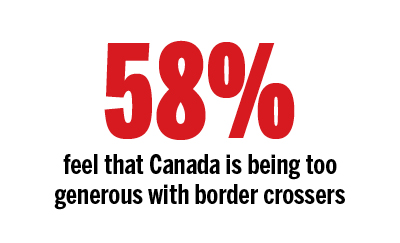
In the Angus Reid Institute survey, 58 per cent of respondents say Canada is too generous with border crossers; only seven per cent say we’re not generous enough.
On this issue, where toughness seems to trump compassion, 48 per cent of Canadians think Scheer is the best leader to manage, compared to 35 per cent for the current Prime Minister. “The Conservatives have taken an issue Canadians were already engaged about and found a way to turn it into an effective wedge and a winner for their leader,” says Shachi Kurl, executive director of the Angus Reid Institute. “The vulnerability for the Liberals is real, and it is both a problem of communication and management.”
Slotting Blair, a former police chief, into a new border portfolio is an acknowledgement that the Liberals are doing something, but they arguably need much more to shore up their base, Kurl says.
The migrant issue has become one of the biggest reasons Canadians want the Liberals turfed. Immigration and refugees were cited by 42 per cent of those who want a change of government—more than taxes, trade, carbon pricing or Trudeau’s ill-fated India trip, and behind only debt and deficits, according to a recent Abacus Data poll showing the Liberals and Conservatives virtually tied, and that 57 per cent of respondents want change. The poll suggests it’s especially top-of-mind for Conservative change voters, but the NDP-inclined are also now more frustrated about immigration than most other files.

In 2016, Kurl’s team found that more Canadians supported the Syrian refugee resettlement than opposed it, though not many more. Most people recognized Syrians were genuine refugees fleeing a terrible situation, but with border crossers, there is public skepticism that they are real refugees, Kurl says. That’s for Immigration and Refugee Board members to judge. Of the 2,664 cases the board handled between last October and March, 42 per cent of claimants were accepted as refugees while the other claims were rejected, abandoned or withdrawn. That’s below the overall acceptance rates of past years, when more than half of claimants were judged worthy of refugee status, though the government cautions it has only concluded a small sample of the more than 20,000 border-crosser cases pending.
The rancorous debate at the federal level expanded to a new front when the Doug Ford government cut federal-provincial co-operation on migrant assistance. Quebec’s more co-operative handling of this file may endure only until the next election. It requested a lesser amount for its claimant-assistance costs, despite handling more claimants than Ontario, and eased its rhetorical pressure after Ottawa pledged $36 million to Quebec in June (while offering Ontario $11 million—money the Trudeau government is now funnelling directly to Toronto). Coalition Avenir Québec, the party leading the Liberals in polls ahead of the October vote, advocates slashing the number of irregular asylum seekers Quebec handles, capping the figure at the province’s share of Canada’s population (about a quarter). The Parti Québécois leader, meanwhile, proposed building a fence at Roxham Road.
The Trudeau Liberals might come to better appreciate, as the Conservatives seem to with border crossers, that “crisis” is a subjective term—and a political reality that may soon be upon them.
A note on methodology” Angus Reid Institute surveyed 1,500 Canadians online between July 25 and 30. A sample of this size would normally carry a margin of error of +/- 2.5 percentage points, 19 times out of 20.